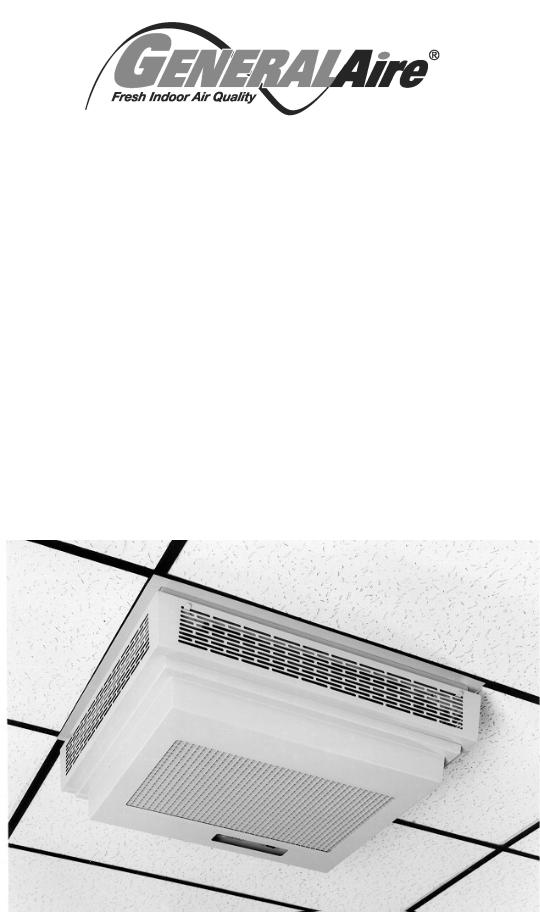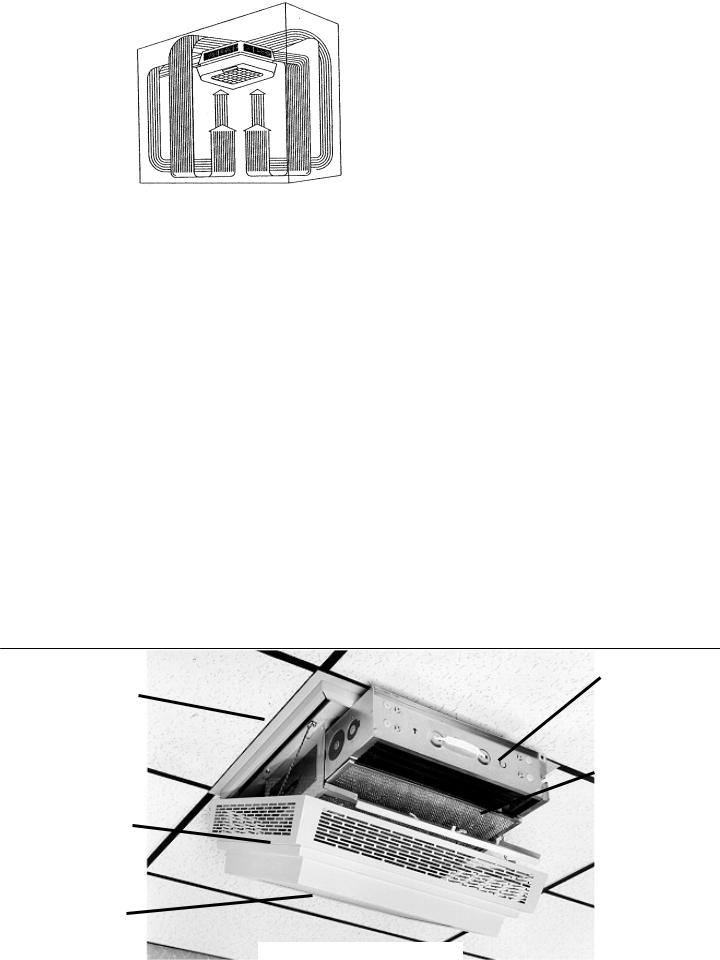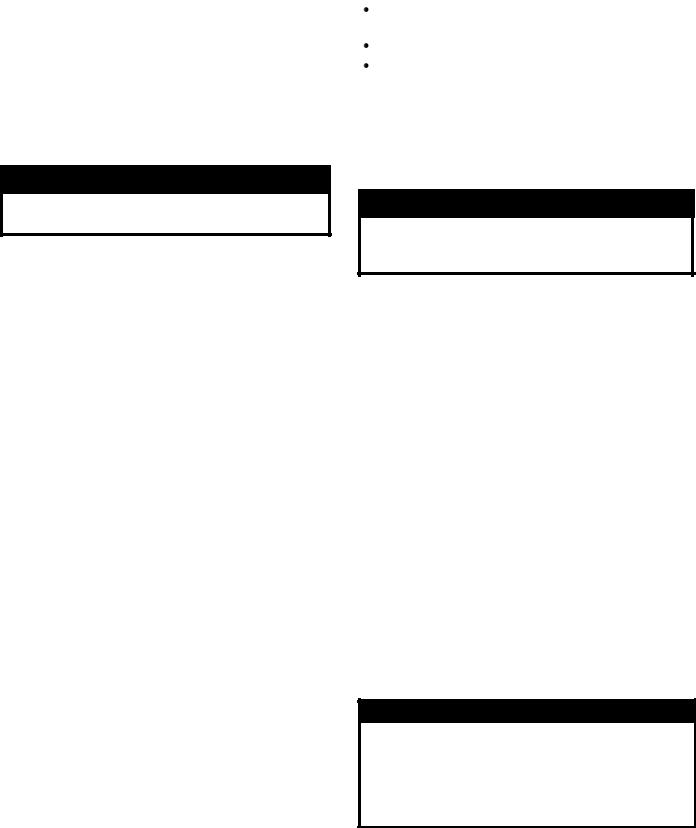General 4172, 4170, 4162, 4165, 4152 Owner's Manual

Operation And Maintenance Manual
SSCB-7 SERIES
SEMI-FLUSH CEILING MOUNTED ELECTRONIC AIR CLEANER
IMPORTANT: PLEASE READ MANUAL BEFORE INSTALLING, OPERATING, CLEANING OR SERVICING UNIT

IMPORTANT: Please read entire instructions before installing the Electronic Air Cleaner.
CONTENTS
SAFETY CONSIDERATIONS |
2 |
WHAT THE ELECTRONIC AIR CLEANER DOES |
2 |
BENEFITS |
2 |
HOW IT WORKS |
2 |
MAJOR COMPONENTS |
3 |
INSTALLATION |
3-4 |
Mounting |
3 |
Wiring |
4 |
OPERATION & MAINTENANCE |
4 |
Operation Check |
4 |
Maintenance Schedule |
4 |
Cleaning |
4 |
SERVICE |
5-7 |
Testing For High Voltage At Power Board |
5 |
Measuring High Voltage At Power Board |
5 |
Replacing A Performance Light |
5 |
Replacing A Power Board |
5 |
Testing The 24 V Transformer |
6 |
Replacing The 24 V Transformer |
6 |
Setting Voltage Of Power Board |
6 |
Setting Approximate Voltage Without High Voltage Meter |
6 |
Testing For Voltage at The Cell |
6 |
Testing Cell For Bad Contacts |
7 |
Testing Cell With An Ohmmeter |
7 |
Replacing A Tungsten Wire |
7 |
Replacing A Fan Motor |
7 |
REMOTE SWITCH CONTROL |
7 |
Electrical Schematic |
8 |
TROUBLESHOOTING GUIDE |
9 |
Exploded View |
10 |
Parts List |
10 |
Technical Data and Dimensions |
11 |
WARRANTY |
12 |
Certified for shock and electrical fire hazard only.
SAFETY CONSIDERATIONS
Read and follow instructions carefully. Follow all local electrical codes during installation. All wiring must conform to local and national electrical codes. Improper wiring or installation may damage the Air Cleaner.
Understand the signal words WARNING and CAUTION which are present in the Installation, Operation & Service Instructions.
WARNING and CAUTION signifies a hazard which could result in property damage, personal injury or death.
WARNING
Before beginning any installation or modification, be certain that the main line electrical disconnect switch is in OFF position. Electric shock could result. Tag disconnect switch with suitable warning labels.
Installation and servicing of Electronic Air Cleaners can be hazardous. Only trained and qualified service personnel should install, repair, or service Electronic Air Cleaners.
Untrained personnel can perform the basic maintenance functions of cleaning and replacing filters.
When working on air cleaning equipment, observe precautions in the manual, labels attached to the unit, and other safety precautions that may apply. Follow all safety codes. Wear safety glasses and work gloves.
WHAT THE ELECTRONIC AIR CLEANER DOES
Your High Efficiency Electronic Air Cleaner has been designed to remove tobacco smoke particles, cooking smoke and grease, atmospheric dust, coal dust, insecticide dust, mites, pollen, mold spores, fungi, bacteria, viruses and more down to 0.01 micron (0.01 micron = 1/2,540,000 of an inch).
BENEFITS
Helps clear up a smokey environment quickly, so customers can dine more comfortably.
Helps employees reduce suffering from irritated eyes, nasal congestion and respiratory problems that lead to absenteeism.
Helps prevent damaging black and greasy particles from staining ceilings, walls and furnishings, reducing the amount of housekeeping and redecorating costs.
Helps to lower energy bills by recycling air rather than exhausting expensive heated or cooled air.
HOW IT WORKS
This Air Cleaner works on the principle of "Electrostatic Precipitation". Millions of airborne pollutants are drawn through the intake grill on the bottom of the Air Cleaner and first pass through a Prefilter which removes all large visible particles such as lint. Next, smaller particles move to a two-stage electrostatic Collecting Cell where they are given a powerful positive charge by the ionizing wires. Charged particles then move into the collecting area where they are attracted to a series of grounded plates. Pollutants are held in this section like a magnet until washed away during cleaning. Clean air is then dispersed from the side grills in four directions allowing superior air flow circulation.
|
|
4 CollectingctingCell |
1 Dirty Air |
|
|
|
|
Pllates |
22Prefilter |
|
|
33Charginr i g |
|
5 ClleanAir |
Sectiion |
|
|
|
|
|
|
|
|
Fig. 1 — Electrostatic Precipitation
2

The Air Cleaner creates a circular air flow pattern which never allows air to rest at the ceiling.
Fig. 2 — Coanda Air Flow
MAJOR COMPONENTS
Description
The Electronic Air Cleaner is approximately 24 x 28 x 15 in (61 x 71 x 38 cm) with 6 in (15.2 cm) of the unit above the ceiling. The cover and exhaust grill which remain below the ceiling are hinged to allow access to the cell and power board. The unit is rated at 700 CFM (1190 m3/hr) on the highest speed setting.
Cabinet
The cabinet is constructed of 20 gauge steel. The external parts have a tough powder-coated, scratchresistant finish. Access to the collecting cell, power box and prefilter is made by releasing the latches of the cover and allowing it to swing down.
The cover is interlocked to cut power to the unit when opened.
Prefilter
The washable prefilter measuring 12.5 x 20 in (31.75 x 50.8 cm) is constructed of multi-layers of aluminum mesh for maximum filtration of large particles.
Collecting Cell
The dual voltage collecting cell is constructed of heavy gauge aluminum to resist rust and damage. The first stage, the ionizing section, is charged at
approximately 7500 VDC. The collecting plates are alternately grounded and charged at 5000 VDC. The arrow on the cells indicates the direction of air flow which must point up towards the fan motor.
Motor and Fan Blade
The motor is 1/33 HP, 1050 RPM, 3-speed, controlled by a 3-position slide switch. The motor is thermally protected. The fan blade is 14 in (35.5 cm) with a 20o pitch.
Electrical Compartment
The removable power box contains the speed control, system switch, high voltage power board, and performance indicator light.
The interlock switch is located in the cabinet body near the wiring compartment.
INSTALLATION
1.Read instructions carefully. Failure to do so may result in product damage or injury.
2.Make sure the sizing is correct for your application.
3.Installation should be done by a knowledgeable technician.
4.After installation, check out operation as provided in these instructions.
Mounting
1.Remove the unit from the box and lay the unit on its back, grill side up.
2.Release the grill by pushing the levers, located in the exhaust grill, toward each other and lift up.
4.Remove the ‘S’ hook from each chain, tilt cover up until the cover releases from the back hinges.
5.Remove the cell and prefilter from the unit.
6.Holes are provided in the cabinet to accommodate 5/16 in (8 mm) threaded rod. Threaded rod can be attached to the angle iron which is laid across the joists, by drilling holes through these supports. Pass threaded rod up through the supports and secure with two nuts and washers. This will allow adjustment of
Blower and motor are hidden above ceiling tiles for space conservation. Advantageous for low ceiling applications where a larger unit would be obstructive.
Hinged cover provides convenient access to grill, prefilter, collecting cell and electrical compartment. Safety interlock cuts power when cover is opened.
Rear hinges permit smooth release of cover for easy installation.
Removable intake grill for easy cleaning.
Fig. 3— Components
Heavy duty collecting cell captures airborne pollutants and simply washes clean.
Washable, aluminum mesh prefilter catches lint and large particles before they enter collecting cell.
3-speed fan control (not shown) allows adjustment of air flow to activity level in room.
3

the unit so that the flange is flush with the underside of the ceiling.
Leave enough room around the Air Cleaner for removal of collecting cell and prefilter.
7.Replace the cell, prefilter and cover. Hook up the safety chain to the cover.
Do not hang the unit with chain only. This will not give the unit the necessary stability when removing the cells or servicing the unit.
Wiring
WARNING
Electrical shock can cause injury or death. Be certain main line disconnect switch is off before wiring.
All wiring must comply with applicable codes and standards. See unit rating label for correct voltage and amperage.
1.Two knockouts are provided, one on top and one on the side of the unit, adjacent to the wiring compartment. For convenience, a wall switch may be installed near the Air Cleaner, in series with the power source, to turn the unit on and off.
2.Remove the cover of the wiring compartment to locate the input leads and ground stud. The Air Cleaner must be grounded for proper operation and safety.
3.Once the unit is mounted and wired, the cover can be replaced on the hinge and the chain replaced on the "S" hooks. Close the cover by sliding the levers toward the center and pushing the cover up into place. Release levers to lock the cover into place.
For information on wiring the remote switch control see page 7.
OPERATION & MAINTENANCE
Operation Check
1.With the cell and prefilter in place and the cover closed, turn the system switch ON.
2.Adjust the fan speed with the slide switch. Insure the unit functions on all speeds.
3.The performance light should be ON, which indicates the power board is functioning properly.
4.If the unit is not functioning properly see the "Troubleshooting Guide"
When the Air Cleaner is new it may arc or periodically make "snapping sounds". A slight odor of ozone may be noticeable. The arcing and odor are due to rough edges and burrs on the cell. These symptoms will disappear during the first few weeks of normal operation. The ozone levels are well below government standards for indoor air concentration.
Maintenance Schedule
The collecting cell and prefilter must be cleaned on a regular basis for the unit to function at its peak efficiency.
The frequency of cleaning will vary from one environment to another. The following is an average wash cycle:
Stores, Offices, Computer & Conference Rooms = 4
Weeks
Cafeterias, Restaurants, Lounges = 3-4 Weeks Bars, Bingo halls = 1-3 Weeks
The unit should be checked on a regular basis to determine the frequency of cleaning required in each location and a cleaning schedule established.
Cleaning
CAUTION
Make sure Air Cleaner switch is OFF before performing any maintenance or removing any components.
1.Turn off the system switch and wait 15 seconds for high voltage to dissipate.
2.Open the cover and cell access door and remove collecting cell and prefilter. Cell plates are sharp.
Handle with care.
3.Place cell in tub and spray completely with DAX Detergent, allowing detergent to run down both sides of plates and ionizing wires. Let sit for 5 minutes. Rinse cell well with hot water (140ºF / 60ºC maximum). Repeat washing process if necessary.
4.If dirt or nicotine remains on plates, let cell soak in hot soapy water for 30 minutes. Never use any instrument to clean the cell, as this may damage the ionizing wires or bend cell plates.
5.Spray prefilter with DAX Detergent and rinse well.
6.To dry cell, tilt on 45º angle against wall with the arrow pointing sideways. Allow to dry completely for 10-24 hours. Place in sunlight for faster drying time.
7.When the cell and prefilter are dry, place them back into the unit. The arrow on the cell points up. The red fiberboard on the cell should line up with the contacts in the cabinet. Close door and cover. If the cell arcs when the switch is turned on or if the performance light does not come on, then the cell may be still wet. Allow more time for drying.
CAUTION
Damage to cell may occur if improperly handled or washed. Do not wash cell in a dishwasher. Never use any object to clean between the cell plates, as this may cause damage to plates or ionizing wires. Never place cell in oven to dry. The edges of the cell may be sharp - handle with care.
The use of DAX Detergent is strongly recommended for cleaning as it is a heavy-duty solution used expressly for removal of accumulated pollutants on cell plates. If used as directed, DAX will not harm aluminum or steel. Any problem arising out of the use of another cleaning agent will void the warranty. Do not use detergents that
4
